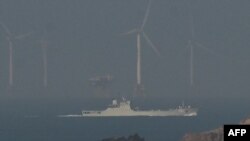Chinese warships and aircraft were still operating around Taiwan on Tuesday, the island's defense ministry said, a day after Beijing declared an end to its massive war games.
China launched three days of military exercises around self-ruled Taiwan on Saturday that saw it simulate targeted strikes and practice a blockade of the island.
The show of force from Beijing, which claims the island as part of its territory, was a response to Taiwan President Tsai Ing-wen's meeting with US House Speaker Kevin McCarthy last week, an encounter it had warned would provoke retaliatory measures.
Taiwan's defense ministry said it had detected nine Chinese warships and 26 aircraft around the island as of 11:00 am (0300 GMT) on Tuesday.
China "organized military aircraft this morning and crossed the median line from the north, the center, and the south", the ministry said, referring to the unofficial but once largely adhered-to border that runs down the middle of the Taiwan Strait.
On Monday, the final day of the drills, the ministry said it had detected 12 Chinese warships and 91 aircraft around the island, with 54 planes crossing into Taiwan's southwestern and southeastern air defense identification zone (ADIZ).
The ADIZ incursions were the highest recorded in a single day since October 2021.
The zone is not the same as Taiwan's territorial airspace, and includes a far greater area that overlaps with part of China's own ADIZ and even some of the mainland.
During the exercises, J15 fighter jets had been deployed off China's Shandong aircraft carrier and were among the aircraft that crossed the median line, the defense ministry added.
A similar number of warships and jets were deployed by Beijing on Saturday and Sunday.
"The Shandong carrier battle group deployed in the Philippine Sea was involved in the drill and the total of 232 air sorties in three days are unprecedented," Alexander Huang, a military expert at Tamkang University in Taipei, told AFP.
Taiwan's President Tsai Ing-wen condemned the military drills on Monday, hours after they officially came to an end, saying China was using Taiwan's engagement with the United States as an "excuse to launch military exercises, causing instability in Taiwan and the region".
"Although China's military exercise has come to an end, our military and national security team will continue to stick to their posts and defend the country," Tsai said.
Aerial blockade
China responded to questions about Tuesday's military presence by reiterating its claim over Taiwan.
"China will resolutely take strong measures to protect national sovereignty and territorial integrity," foreign ministry spokesperson Wang Wenbin said at a regular press briefing.
"Taiwan is an inseparable part of Chinese territory. There is no so-called Taiwanese defence ministry."
After the three-day exercise, the Chinese military said it had "successfully completed" tasks related to its "Joint Sword" drills.
The war games saw Beijing simulate "sealing" off the island, with state media reporting dozens of planes had practiced an "aerial blockade".
The United States, which had repeatedly called for China to show restraint, on Monday sent the USS Milius guided-missile destroyer through contested parts of the South China Sea.
"This freedom of navigation operation upheld the rights, freedoms, and lawful uses of the sea," the US Navy said in a statement.
The deployment triggered condemnation from China, which said the vessel had "illegally intruded" into its territorial waters.
Separately, Beijing warned that Taiwanese independence and cross-strait peace were "mutually exclusive", blaming Taipei and unnamed "foreign forces" supporting it for the tensions.
The White House said that relations with Beijing were rocky following the drills.
Analysts said the continued presence of Chinese ships and aircraft even after the drill was declared over could signal an increase in daily military displays.
"I hope it will not become the normal state," said Tzeng Yi-suo, a research fellow at the Institute for National Defense and Security Research in Taipei.
"Taiwan's military has been working hard to counter the... attrition and harassment."















